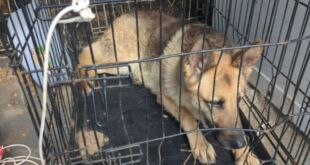When a beautiful pup has a dental problem, it’s time to call a veterinarian. But when it runs in the family, researchers take the case.
Clemson University researcher Leigh Anne Clark and her graduate student, Sydney Abrams, study inherited diseases in canines. They have worked previously on conditions that affect Shetland Sheepdogs, those fluffy “Sheltie” herding dogs that closely resemble a miniature version of Lassie. The pair collaborated on a paper titled “Variants in FtsJ RNA 2′-O-Methyltransferase 3 and Growth Hormone 1 are associated with small body size and a dental anomaly in dogs,” which will be published the week of Sept. 21 in PNAS, the official journal of the National Academy of Sciences.
After Sheltie breeders sought answers about maxillary canine-tooth mesioversion, Clark and Abrams’ subsequent research led to a groundbreaking discovery.
“We wanted to find the genetic basis for lance canines and ended up discovering that it’s related to the dog’s body size,” said Abrams, who is lead author on the paper. “This is one of the first times a trait in dogs has been attributed directly to genes influencing growth.”
“The condition is known among Sheltie breeders as lance canine,” added Clark, an associate professor in the College of Science’s Department of Genetics and Biochemistry. “That’s because that canine tooth points forward, like a lance or spear, instead of pointing down like it should.”
The tooth can be extracted or fixed with orthodontics, but that doesn’t address its cause. If left untreated, it can cause ulcerations on the lip or prevent the dog from closing its mouth. It can also lead to periodontal disease.
“It was having an impact on the breed because when you compete in conformation trials, the teeth are one of the things they look at,” Clark said. “You must have your canine tooth and it has to be pointing down—otherwise, it’s a fault.”
Dogs with lance canine can become pets, of course, but they are not shown.
“If you’re not shown, you are less likely to be bred,” Clark said. “These dogs are getting pulled from the breeding pool and you’re losing genetic diversity over a crooked tooth.”
Because the condition is rarely seen outside the Sheltie breed, Clark said she was sure it was heritable. Getting to its source would help breeders work toward eliminating it.
“We took a genome-wide approach—looking at genetic markers that span the entire genome—hoping to find one or more of these markers associated with lance canine,” she said.
This was no small task. Abrams began this study while she was still an undergraduate.
“I started working on dental abnormalities in Shelties in 2017 as an undergraduate and received funding from the Clemson University Honors College,” Abrams said. “This enabled me to continue my research at a high level.”
“It took years to collect these samples,” Clark added. “It’s slow and tedious to get enough samples to do these kinds of studies.”
The dogs whose samples were used could not share common grandparents, so Abrams collected more than 200 samples and ultimately used 78 of those in genome-wide research.
“I contacted owners from all over the world to collect the samples,” said Abrams, who received her Bachelor of Science in genetics in 2019 before joining Clark’s laboratory as a graduate student. “I even got to present a portion of this work at a canine and feline genetics conference in Bern (Switzerland) in May 2019.”
Abrams and Clark’s efforts paid off in a surprising way.
“We did find an association on chromosome 9,” Clark said. “In this region of the chromosome, there were about 30 genes. We generated sequence from a Sheltie with both canine teeth affected. We looked at those 30 genes for a variation that might have an effect. We found two variations in two different genes that looked like they could be problematic. One of the genes was growth hormone.”
Because that gene is necessary for normal growth, Clark and Abrams went back to the study population and asked the owners to submit their dogs’ height and weight.
“What we discovered is that dogs with lance canine are, on average, one inch shorter and six pounds lighter than unaffected Shetland Sheepdogs,” Clark said.
And in a small breed that averages about 20 pounds and is 13 to 16 inches at the shoulder, this variation is significant.
“Nobody had noticed before,” Clark said.
But owners quickly had an “aha” moment as they made the connection.
“Next, we looked at these two variations in the genomes of 224 other breeds and wild canids,” Clark said. “But they were only in toy breeds. They are all tiny dogs. The consequence of the growth hormone gene mutation is a mutant protein that is exactly the same as the one found in humans with pituitary dwarfism.”
There is more work to be done, including exploration of why some canines are prone to missing teeth and what connection that might have to other health issues.
“Missing teeth is interesting because it is in all breeds, but is more common in small breeds,” Clark said. “Dogs with two lance canines are significantly more likely to have missing teeth than a dog that has one lance canine. There’s some relationship there.”
Source: PHYS.ORG
Please Note: This article is not edited by DogExpress Team!

 DogExpress
DogExpress

















 in Chandigarh, India.
in Chandigarh, India. 
